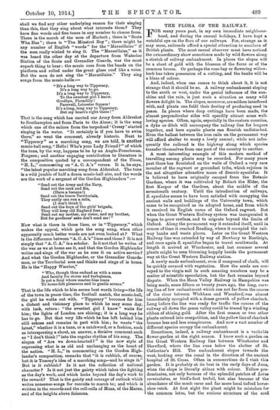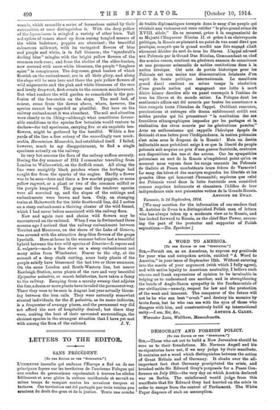THE FLORA OF THE RAILWAY.
FOR many years past, in my own immediate neighbour- hood, and during the annual holidays, I have kept a watchful eye on the flora of our railways. For, strange as it may seem, railroads afford a special attraction to numbers of British plants. The most casual observer must have noticed the extraordinary show sometimes made by wild flowers along a stretch of railway embankment. In places the slopes will be a sheet of gold with the blossom of the furze or of the common broom. Or perhaps the rose-bay or flowering willow- herb has taken possession of a cutting, and the banks will be a blaze of colour.
And, indeed, when one comes to think about it, it is not
strange that it should be so. A railway embankment sloping to the south or west, under the genial influence of the sun- shine and the rain, is just such a situation as many wild flowers delight in. The slopes, moreover, are seldom interfered with, and plants can fulfil their destiny of producing seed in peace. In places where deep cuttings have been made, the almost perpendicular sides will speedily attract some wall- loving species. Often, again, especially in the eastern counties, a dyke or ditch will accompany the railway line for leagues together, and here aquatic plants can flourish undisturbed. Even the ballast between the iron rails on the permanent way will afford shelter to many a lowly annual; while not infre- quently the railroad is the highway along which species transfer themselves from one part of the country to another.
A moat interesting example of this modern method of travelling among plants may be recorded. For many years past there has flourished on the walls of Oxford a very rare member of the ragwort or groundsel tribe, which rejoices in the not altogether attractive name of Senecio squalidus. It is believed to have originally escaped from the Botanic Gardens, where it was cultivated by Bobart the Elder, the first Keeper of the Gardens, about the middle of the seventeenth century. Until the introduction of railways, S. squalidus seems to have been satisfied with occupying the ancient walls and buildings of the University town, which came to be recognized as its adopted home, and from which it received its English name of the Oxford ragwort. But when the Great Western Railway system was inaugurated it
began to grow restless, and to migrate beyond the limits of Oxford. Along the permanent way it extended itself, until in course of time it reached Reading, where it occupied the rail- way banks and waste places. Later on the Great Western Railway line was extended by way of Newbury to Eastleigh, and once again S. squalidus began to travel southwards. At length it arrived at Winchester, and last summer several plants might be seen blooming happily beside the permanent way at the Great Western Railway station.
A newly made embankment, even if composed of chalk, will be quickly covered with vegetation. How the seeds are con- veyed to the virgin soil in such amazing numbers may be a matter of scientific speculation, but the fact remains beyond dispute. When the Meon Valley Railway in Hampshire was being made, some fifteen or twenty years ago, the long, curv- ing line of low embankment which ran not far from the course of the river between Wickham and Warnford; was almost immediately occupied with a dense growth of yellow charlock. Long before the line was ready for traffic the course of the railway all down the green valley could be traced by a winding ribbon of shining gold. After the first season or two other plants entered into competition, and the yellow line of charlock became less and less conspicuous. And now a vast number of different species occupy the embankment.
Sometimes, indeed, a railway embankment is a veritable
flower-garden at the right season. I know such a garden on the Great Western Railway line between Winchester and Shawford, where the line runs below the shelter of St. Catherine's Hill. The embankment slopes towards the west, looking over the canal in the direction of the ancient hospital of St. Cross. Often in summertime do I visit this garden. It is probably at its best in the early days of June, when the slope is literally ablaze with colour. Yellow pre- dominates, not only because of the splendid patches of Lotus corniculatus, or bird's-foot trefoil, but also because of the abundance of the much rarer and far more local tufted horse- shoe vetch. At first sight the plant might be mistaken for the common lotus, but the curious structure of the seed
vessels, which resemble a series of horseshoes united by their extremities, at once distinguishes it. With the deep yellow of the leg umiaosae is mingled a variety of other hues. Tall red spikes of mines shoot up from among tangled masses of the white bedstraw; poppies are abnndant ; the beautiful calcareous milkwort, with its variegated flowers of blue and purple and white, is in full blossom; the "speedwell's darling blue" mingles with the bright yellow flowers of the common rock-rose ; and from the shelter of the elder-bushes, now covered with snow-white blossoms, the purple "foxglove spire" is conspicuous. The dog-roses, great bushes of which flourish on the embankment, are in all their glory, and along the slope will be seen here and there the pale yellow flowers of wild mignonette and the pink and white blossoms of the rare and lovely dropwort, first-cousin to the common meadowsweet. But what renders the wild garden so remarkable is the pro- fusion of the bee-orchis on the slope. The seed had, of course, come from the downs above, where, however, the species cannot be regarded as plentiful. But here on the railway embankment it was abundant. The soil and situation were clearly to its liking—although what constitutes favour. able conditions to the species few botanists would venture to declare--for tall specimens, carrying five or six exquisite bee- flowers, might be gathered by the handful. Within a few yards of the line a fine colony of the exceedingly rare musk- orchis, lierminium lifonorchis, had established itself. I failed, however, much to my disappointment, to find a single specimen actually on the railway.
In very hot seasons the flora of the railway suffers severely. During the dry summer of 1911 I remember travelling from London to Walberswick, on the Suffolk coast. All along the line were unsightly black patches where the herbage had caught fire from the sparks of the engine. Hardly a flower was to be seen—here and there a few scarlet poppies, or some yellow ragwort, or a plant or two of the common milfoil or the purple knapweed. The grass and the tenderer species were all scorched up, and the slopes of the cuttings and embankments were brown and bare. Only, on changing trains at Halesworth for the little Southwold line, did I notice on a steep embankment a thriving cluster of the wild fennel, which I had never before associated with the railway flora.
Now and again rare and choice wild flowers may be encountered on the railroad. When I was in Switzerland three seasons ago I noticed that the railway embankment between Territet and Montreux, on the shore of the Lake of Geneva, was covered with the attractive deep-blue flowers of the grape hyacinth. Here at home in the summer before last a beautiful hybrid between the two wild species of Linaria—L. repens and L. vulgaris—made a fine show on a steep embankment not many miles from Winchester. Nearer to the city, at the summit of a deep chalk cutting, some lusty plants of the purple salsify have blossomed the last two or three summers. On the same London and South-Western line, but nearer Eastleigh Station, some plants of the rare and very beautiful Epipactus palustris, or marsh helleborine, have taken a fancy to the railway. Escaping from a marshy swamp that adjoins the line, a dozen or more plants have invaded the permanent way. There they were to be seen in August last year actually bloom- ing between the iron rails. They were naturally somewhat stunted individuals, for the E. palustris, as its name indicates, is a frequenter of swampy places, and the permanent way did not afford the sort of hospitality desired; but there they were, making the best of their unwonted surroundings, the choicest species in the strangest situation that I have yet met
with among the flora of the railroad. J. V.



































 Previous page
Previous page